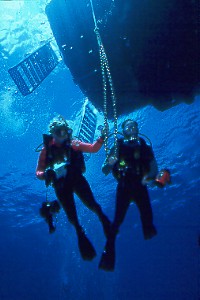|
Now
that you've practiced with your camera in the pool, and you have
an inkling what all the knobs and buttons are for,
and you've been fine tuning your buoyancy so you can
hover motionless in the water column, you are now itching to
take some pictures.

Arrowcrab in
Flight
Taken with a Nikonos V, closeup set, at
f16, strobe on TTL, with focus set at infinity. Taken at 100'
-this crab was all over me, in my BC, then from the coral, it
leaps into the unknown. Usually found at shallow depths. This
was the only 'good' shot out of about a dozen taken. Arrowcrab
around 3" wide.
There are many types of photos you can utilize in
underwater photography. There is macro/ closeup, wide
angle, close focus wide angle, natural light, strobe -
flash fill, dual strobe, backlighting, and silhouettes. I am
sure I forgot something....
One thing I usually tell my
photography students is to try not to get overwhelmed by all
the ways you can take pictures, but focus on one thing (no pun
intended), get good at it - or at least comfortable, and
then move on. If you would like to have the most
"keepers" per roll, try macro or closeup first.

Tubestras
Taken
with a Nikonos V- 1/1 extension tube, at f 22, Strobe on TTL,.
Soft cup corals, feeding...usually under ledges/caverns, open
up to feed at night. Tubestras are only around ½ to 1 inch
high when opened
Why, is that,
you ask? Well, with macro, you set your aperture (to f16
or f22 depending on your subject, strobe strength/distance and
film), set your strobe (distance and strength -ususally
TTL), and point and shoot.
You will be
working very close to your subjects - inches - so you should
concentrate on subjects that don't move! There are so many
subjects that can be very patient for you, as they are going
nowhere....and they can include anemones, tube worms,
corals, sponges, many mollusks (except your squid and
octopi -they can move pretty darn fast and they're too big for
macro!), crinoids, sea stars, brittle stars, urchins,
tunicates...you get the idea.

Spotted shrimp in
Anemone
Taken with a Nikon N90 in a Nexus housing, 60mm
macro lens. 60th sec, F11 -16, dual strobes set on TTL. Shrimp
is only about ¼ inch high, I have trouble actually seeing
them, as they are transparent, the anemone is no larger than
my hand, but I am able to be back enough with the 60 mm lens
so as to not to disturb the creatures.
Most of the newer point and shoot underwater cameras
out today have some form of a screw on closeup lens with a
"framer" - a metal rod with a frame that sticks out several
inches from the lens. As with any framer, and that includes
the Nikonos system, you must get your subject within the
confines of the framer.
The closeup lens can be put on and
removed underwater, as it goes over your primary lens. If you
are using the Nikonos system, and choose to use
extension tubes- to take smaller subjects- these tubes
are put between the camera and lens, with a framer, then those
cannot be changed out underwater. Depending on what system you
have, the size of your subject, that will fill the frame can
range from around 5" down to 2x lifesize on 35mm film. For the
entire subject to be sharp, remember, it must be flush
and flat within the framer.
Ah-ha! But there you are,
poking your framer at subjects, and those that can, flee at
the sight of you! What do you do? Well, spend some money and
get a housing for your SLR! You would not use extension
tubes, or closeup kits with a framer! You would get a
60mm or a 105mm macro lens. The advantage is you can be away
from your subjects, they go about their business, and you can
concentrate on composition, lighting, and get close fish
portraits that are extremely difficult, if not impossible with
a framer. You can also open your aperture to capture more of
the background, if that is one of the effects you'd like.
There are advantages and
disadvantages to every type of camera system, but practice
with what you have, and you will find macro photography to be
the easiest and the most gratifying with the greatest number
of well exposed, well composed shots per roll. Good luck!! As
these articles are only "tips", I am only giving you very
basic information , and like everything else in life, things
are more complicated than we'd like...but here I am, ready to
answer any questions you may have....just email me at:
pgoldberg@goldenimages-photo-scuba.com
|



